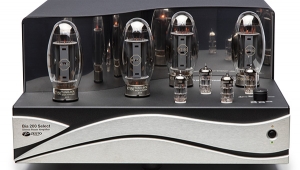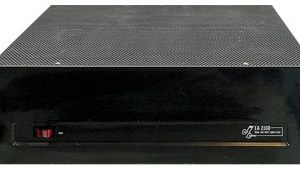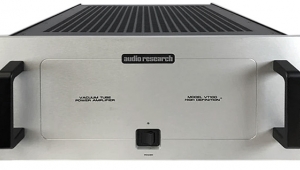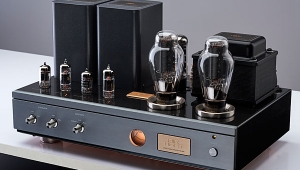| Columns Retired Columns & Blogs |
Cary Audio Design CAD-805 monoblock power amplifier Page 3
The impedance magnitude should be fairly flat for efficient power delivery. The nominal impedance should be 8 ohms or higher, and ideally there should be no dips below 4 ohms—at least below 500Hz. Any tube amp is limited in its current delivery, and the lower the load impedance, the greater the current demand. As a simple example, compare two loudspeakers: one with an 8 ohm impedance vs one with a 4 ohm impedance. Assuming purely resistive loads, the current demand of the 4 ohm load is twice that of the 8 ohm load. I'm appalled at the recent trend toward vanishing-impedance loudspeakers. An impedance of 2 ohms or lower below 500Hz—the power-hungry musical range—is Krell country, not tube territory. There was a time when a 16 ohm nominal-impedance speaker was commonplace. More speaker designers should be considerate of the special needs of tube amplifiers.
Preliminaries
If I told you that some of this galaxy's purest, most musical sound comes in a 10W or 20W package, would you (as some have done) shrug your shoulders and say, "What's it good for?" Or would you scramble around for a compatible load? Okay, so I can't use the Sound-Lab A-1 with the Cary 805. But if the ticket to Nirvana says "single-ended," I'd most definitely search Speakerland for a suitable mate.
So I gathered several loaner speakers which (at least on paper) had a good chance of partnering the 805. These included the Audio Note 3/SPX-SE, the Reel-to-Reel Design Legacy Protege, the Solo Electronics H500, and the Audio Artistry Mozart.
Speaker cable was primarily TARA Labs RSC. The front-end consisted of the Jadis JP 80MC preamp or the Air Tight ATC-2 line-level preamp used with Air Tight's matching ATE-1 phono preamp and the Ikeda step-up transformer; the Basis Ovation turntable outfitted with a Graham 1.5t arm and an Audio-Technica ART-1 cartridge; and the Theta DS Pre Generation III used with both Micromega and California Audio Labs Delta CD transports. Interconnects were mostly Mapleshade's Omega Mikro and Hovland/Sonic Purity.
Sonic impressions
Audio Note 3/SPX-SE: Because Audio Note UK distributes the fabulous single-ended amps of Audio Note Japan, you might have guessed that their speakers would be eminently compatible with 10W amps. And indeed that seemed to be the case—on paper. The Model 3-SE ($2995/pair) is said to possess a 6 ohm nominal impedance and is rated at 95.5dB at 1W at 3m. That's one hell of a sensitivity for a direct-radiator two-way design with a 7.5" woofer. While I believe the 6 ohm nominal impedance rating is reasonable, the sensitivity figure is straight out of the Twilight Zone. My measurements show a figure of 90dB/W/m to be much more appropriate.
The 3 was stand-mounted using the MAF stands provided by Sounds Like Music, Audio Note's US distributor. I would describe the 3's low end as gelatinous, lacking definition and rhythmic strength. Nor is there much deep-bass extension. This may be due to the 3's enclosure construction: For its volume, the cabinet is distressingly lightweight. Although the lower treble is a bit too polite and laid-back, there's plenty of upper treble. But it's quite excitable in nature, which means that the sound is often raspy and raucous. (A time-domain measurement of the tweeter would probably not be a pretty sight.) The Model 3's only sonic virtue is its reproduction of the midrange's core with admirable tonality and decent soundstage transparency.
Ironically, a single-ended amp's weaknesses at the frequency extremes are blessings with this sort of speaker. The 805's inherent loss of bass extension wasn't noticeable, and with vinyl playback was actually welcome: it "filtered" out subsonic garbage which can overdrive a bass-reflex-loaded woofer. At the other extreme, the amp's closed-in presentation tended to tame treble nasties.
The 805s thus catered to the needs of the Audio Note 3s. I found them to be much more listenable with these speakers than the Jadis JA 200s, even though the Jadises sounded faster and more transparent. The 805s highlighted the real glory of the mids with a suave, direct presentation that caressed a human voice as only divine intervention can. It wasn't so much that Marlene Dietrich (Mythos Marlene Dietrich, German EMI-Electrola 7 91287 1) sounded so good, but that her expressiveness was so well facilitated. In this, the 805s' role as communicators became rapidly clear as they recast harmonic textures in a more believable fashion. Whether this was a coloration or the gospel truth wasn't clear to me at this early stage, but I didn't really care—the music was just more enjoyable.
Reel-to-Real Legacy: My sample of the Legacy was a high-sensitivity version of the standard Protege, made expressly for use with Coda Technologies' 25W model 2.5. Though I didn't measure it, I estimated the Legacy's sensitivity to be in the low 90s. The bad news was that the impedance magnitude dips as low as 2 to 3 ohms below 70Hz.
The Legacy possesses undeniable flair, and, from my experience with the Coda 2.5, it certainly can boogie, even with only a few watts. Its inherent character is on the bright side of reality, with a lean midbass region. The soundstage, program material permitting, is quite panoramic, with excellent dimensionality. Bass extension is decent, with tight bass definition and a nice rhythmic drive. The midrange sounds sweet and cohesive. The treble balance, however, forced me to listen to the tweeters off-axis, with the speakers toed-in to the point where the tweeter axes crossed in front of the listening seat. The Legacy was stand-mounted using factory-supplied stands.
The lively nature of the Legacy's aluminum-dome tweeter was laid bare by Classé Audio's 700 monoblocks. When the tweeter was hit pretty hard, it started imitating a fire-breathing dragon: scorching heat cloaked with a thick metallic accent. This tendency to spit fire was subdued enough with the Coda 2.5 that my ears were no longer badly singed. It was, therefore, amazing to witness the degree to which the 805 tamed the Legacy's highs—a night-and-day difference. The extreme treble actually sounded closed-in, while the lower-treble brightness was almost totally tempered, with greatly reduced sibilance.
The midrange was infused with a romantic blush. Harmonic textures were more liquid and flowing. A tropical warmth permeated the core of the music, like an electric blanket on a cold winter's night. Tommy Flanagan's graceful touch on the piano blends well with George Mraz's strong bass technique and Al Foster's dynamic drumming on Nights at the Vanguard (Uptown UP27.29). Rudy Van Gelder's live recording perfectly captures the mood and the feeling of being there, and the Vanguard's good vibes were superbly reproduced by the 805.
- Log in or register to post comments



































